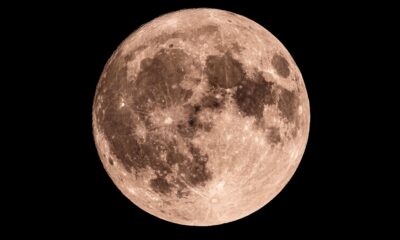Science
Satellite Images Reveal Mesovortices in Hurricane Melissa’s Fury

Hurricane Melissa, a powerful storm wreaking havoc across the Caribbean, has captured attention not only for its strength but also for unique atmospheric phenomena visible from space. Satellite images from the GOES-19 satellite, taken on October 28, 2023, reveal the formation of mesovortices around the hurricane’s eye. According to the National Oceanic and Atmospheric Administration (NOAA), these mesovortices are “small-scale rotational features” that emerge under conditions of significant differences in wind speed and direction.
As of October 28, Hurricane Melissa made landfall in Jamaica as a Category 5 storm, characterized by sustained winds reaching 185 miles per hour (295 kilometers per hour). This classification marks Melissa as one of the most powerful hurricanes recorded in the Atlantic Ocean. The destruction on the island is severe, with emergency authorities reporting that approximately 72% of Jamaica is without power and 65% of mobile phone sites are non-operational. Desmond McKenzie, deputy chair of Jamaica’s disaster risk management council, reported at least four fatalities in southwest Jamaica, although he did not provide further details.
The impact of Hurricane Melissa extended beyond Jamaica. In Haiti, at least 25 people have been confirmed dead due to flooding, with 18 others reported missing. Meanwhile, Cuba experienced the storm as a Category 3 on October 29, 2023, without reported fatalities, though many communities are still struggling with power outages and disrupted communication services due to damaged infrastructure.
As of the morning of October 30, 2023, Hurricane Melissa had weakened to a Category 2 storm, with sustained winds near 105 mph (169 kph). It is currently positioned approximately 515 miles (830 kilometers) southwest of Bermuda, which remains under a hurricane warning as the storm continues its path across the Atlantic.
The scientific consensus attributes the intensification of storms like Melissa to human-driven climate change, which has led to more severe weather patterns globally. As communities in the Caribbean grapple with the aftermath of this devastating storm, the urgency for comprehensive disaster management and climate resilience strategies becomes increasingly clear.
-

 World2 weeks ago
World2 weeks agoGlobal Air Forces Ranked by Annual Defense Budgets in 2025
-

 World2 weeks ago
World2 weeks agoMass Production of F-35 Fighter Jet Drives Down Costs
-

 Science2 weeks ago
Science2 weeks agoTime Crystals Revolutionize Quantum Computing Potential
-

 Top Stories2 weeks ago
Top Stories2 weeks agoNew ‘Star Trek: Voyager’ Game Demo Released, Players Test Limits
-

 World2 weeks ago
World2 weeks agoElectrification Challenges Demand Advanced Multiphysics Modeling
-

 Top Stories2 weeks ago
Top Stories2 weeks agoDirecTV to Launch AI-Driven Ads with User Likenesses in 2026
-

 Entertainment2 weeks ago
Entertainment2 weeks agoFreeport Art Gallery Transforms Waste into Creative Masterpieces
-

 Lifestyle2 weeks ago
Lifestyle2 weeks agoDiscover Reese Witherspoon’s Chic Dining Room Style for Under $25
-

 Health2 weeks ago
Health2 weeks agoGavin Newsom Critiques Trump’s Health and National Guard Plans
-

 Lifestyle2 weeks ago
Lifestyle2 weeks agoLia Thomas Honored with ‘Voice of Inspiration’ Award at Dodgers Event
-

 Entertainment2 weeks ago
Entertainment2 weeks agoFast & Furious Coaster Hits the Track at Universal Studios
-

 Science2 weeks ago
Science2 weeks agoWaning Crescent Moon: What to Expect on October 17









